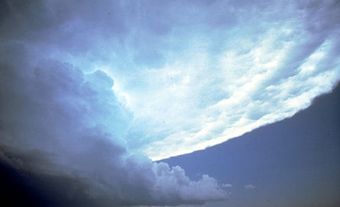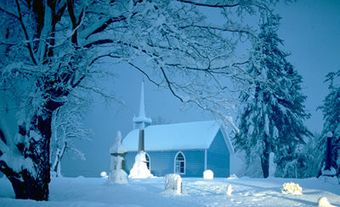La Niña
La Niña describes an extensive cooling of the waters in the tropical eastern Pacific Ocean. To qualify as a full-fledged La Niña, the cooling must persist for at least 3 seasons. La Niña events are cyclical, recurring every 3 to 5 years, but the interval can vary from 2 to 10 years. Most episodes last about 9 to 12 months, although some events persist for as long as 2 years.
For centuries, La Niña was known as "El Viejo," "anti- EL NIÑO" or simply "cold-El Niño." In the mid-1980s, the term La Niña, Spanish for "the little girl," first appeared. In many ways La Niña is the flip-side of the more popular Pacific phenomenon, El Niño, Spanish for "the little boy" - a warming of the upper ocean waters found in La Niña's neighbourhood, off the coast of Peru and Ecuador. La Niña is sometimes described as El Niño's "bratty little sister."
In that region of the Eastern Pacific, the prevailing trade winds are easterly. The lower-level winds drag or push the warm surface water westwards towards Indonesia, the Philippines and Australia. The ocean stirring upwells deep cooler waters to the surface along the South American coast. For reasons not yet fully understood, every 3 to 5 years the easterly trade winds blow even stronger and are more sustained than normal, intensifying the upwelling beyond the coast to the central Pacific near the International Date Line. During La Niña episodes, sea-surface temperatures can be as much as 3 or 4 degrees below normal.
The cooler waters of La Niña generally weaken and modify the circulation of the JET STREAM, which in turn has a marked effect on the normal weather patterns for most of the globe.
La Niña normally exerts much less of a global impact than El Niño, enhancing conditions that are more or less normal. Thus, under La Niña's grip, normally wet Indonesia becomes wetter, and winters in Canada are often colder and snowier than normal. However, the weather associated with La Niña tends to be quite variable depending on such factors as its strength, the depth and geographic extent of the cool waters and the pre-existing atmospheric circulation. Among the normal weather effects of La Niña are wetter monsoons and flooding on the Indian subcontinent; torrential rains and floods in southeast Asia and northern and eastern Australia; cool and wet winters in southeastern Africa; and warm and dry conditions along the coast of Peru and Ecuador.
La Niña favours the formation of more and intense hurricanes in the North Atlantic Ocean. Three recent La Niña periods - 1988-89, 1995-96 and 1997-98 - were among the most active periods this century for Atlantic hurricanes.
North America typically feels the effects of La Niña during the winter and early spring. Wetter-than-normal conditions occur across the Pacific Northwest, British Columbia and Alaska. On the other hand, it delivers drier, warmer and sunnier weather along the southern tier of the United States from California through Texas to Florida. Northern states west of the Great Lakes generally experience colder and snowier winters. During La Niña episodes, there is also a greater risk of wildfires in Florida and dryness in the North American plains. The great dust bowl drought of the 1930s is thought to have been caused by a decade of La Niña-like conditions and was likely responsible, in part, for the severe drought in the American midwest in 1988.
During La Niña winters in Canada, the jet stream assumes its more normal mid-continental location. Because the mild air and cold air are never too far away, winters usually comprise alternating bouts of freezing and thawing. Overall, in Western and Central Canada, most La Niña winters tend to be colder than normal by 1 to 2°C, and snowfall amounts are greater than normal from the interior of BC to the St Lawrence Valley. During 8 La Niña episodes since 1950, 6 of the winters across Canada were colder than normal (2 were near-normal) and 7 were snowier than normal.
In the 20th century, there have been 18 La Niñas, compared to 25 El Niños. It is uncommon for La Niña to follow El Niño; only 5 times this century has the cool phase followed immediately on the heels of its warm-event brother.
See also OCEAN CURRENT.

 Share on Facebook
Share on Facebook Share on X
Share on X Share by Email
Share by Email Share on Google Classroom
Share on Google Classroom


